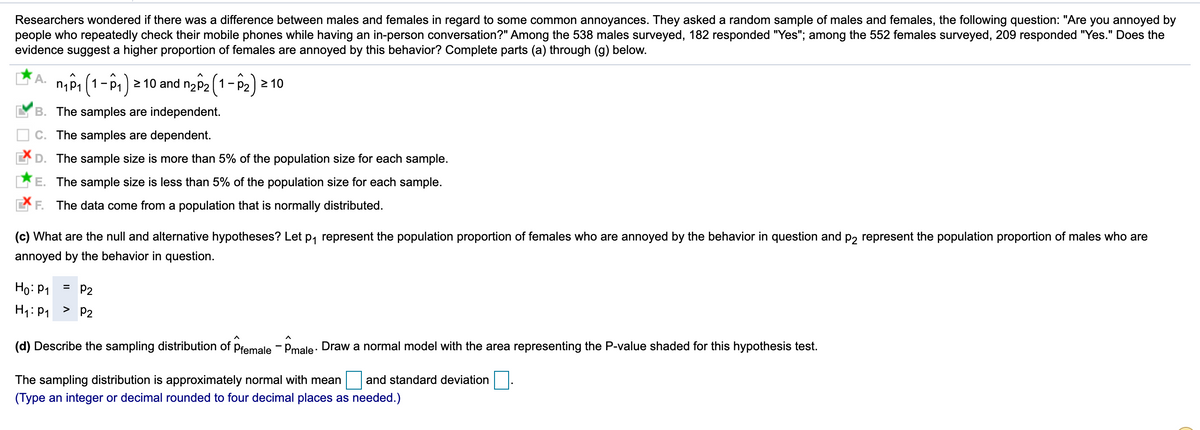Researchers wondered if there was a difference between males and females in regard to some common annoyances. They asked a random sample of males and females, the following question: "Are you annoyed by people who repeatedly check their mobile phones while having an in-person conversation?" Among the 538 males surveyed, 182 responded "Yes"; among the 552 females surveyed, 209 responded "Yes." Does the evidence suggest a higher proportion of females are annoyed by this behavior? Complete parts (a) through (g) below. *A. niêi (1-â1) 2 10 and ngô2(1-P2) 2 10 B. The samples are independent. O c. The samples are dependent. ED. The sample size is more than 5% of the population size for each sample. L'E. The sample size is less than 5% of the population size for each sample. F. The data come from a population that is normally distributed. (c) What are the null and alternative hypotheses? Let p, represent the population proportion of females who are annoyed by the behavior in question and p2 represent the population proportion of males who are annoyed by the behavior in question. Ho: P1 = P2 H:P1 > P2 (d) Describe the sampling distribution of premale - Pmale- Draw a normal model with the area representing the P.value shaded for this hypothesis test. The sampling distribution is approximately normal with mean and standard deviation. (Type an integer or decimal rounded to four decimal places as needed.)
Researchers wondered if there was a difference between males and females in regard to some common annoyances. They asked a random sample of males and females, the following question: "Are you annoyed by people who repeatedly check their mobile phones while having an in-person conversation?" Among the 538 males surveyed, 182 responded "Yes"; among the 552 females surveyed, 209 responded "Yes." Does the evidence suggest a higher proportion of females are annoyed by this behavior? Complete parts (a) through (g) below. *A. niêi (1-â1) 2 10 and ngô2(1-P2) 2 10 B. The samples are independent. O c. The samples are dependent. ED. The sample size is more than 5% of the population size for each sample. L'E. The sample size is less than 5% of the population size for each sample. F. The data come from a population that is normally distributed. (c) What are the null and alternative hypotheses? Let p, represent the population proportion of females who are annoyed by the behavior in question and p2 represent the population proportion of males who are annoyed by the behavior in question. Ho: P1 = P2 H:P1 > P2 (d) Describe the sampling distribution of premale - Pmale- Draw a normal model with the area representing the P.value shaded for this hypothesis test. The sampling distribution is approximately normal with mean and standard deviation. (Type an integer or decimal rounded to four decimal places as needed.)
Holt Mcdougal Larson Pre-algebra: Student Edition 2012
1st Edition
ISBN:9780547587776
Author:HOLT MCDOUGAL
Publisher:HOLT MCDOUGAL
Chapter11: Data Analysis And Probability
Section: Chapter Questions
Problem 8CR
Related questions
Topic Video
Question

Transcribed Image Text:Researchers wondered if there was a difference between males and females in regard to some common annoyances. They asked a random sample of males and females, the following question: "Are you annoyed by
people who repeatedly check their mobile phones while having an in-person conversation?" Among the 538 males surveyed, 182 responded "Yes"; among the 552 females surveyed, 209 responded "Yes." Does the
evidence suggest a higher proportion of females are annoyed by this behavior? Complete parts (a) through (g) below.
n,Pi (1-P1) 2 10 and n2P2 (1-P2) 2 10
- p.
B. The samples are independent.
C. The samples are dependent.
D. The sample size is more than 5% of the population size for each sample.
E. The sample size is less than 5% of the population size for each sample.
F. The data come from a population that is normally distributed.
(c) What are the null and alternative hypotheses? Let p, represent the population proportion of females who are annoyed by the behavior in question and P2 represent the population proportion of males who are
annoyed by the behavior in question.
Ho: P1
P2
H1: P1 > P2
(d) Describe the sampling distribution of pfemale - Pmale: Draw a normal model with the area representing the P-value shaded for this hypothesis test.
The sampling distribution is approximately normal with mean
and standard deviation
(Type an integer or decimal rounded to four decimal places as needed.)
Expert Solution
This question has been solved!
Explore an expertly crafted, step-by-step solution for a thorough understanding of key concepts.
This is a popular solution!
Trending now
This is a popular solution!
Step by step
Solved in 2 steps

Knowledge Booster
Learn more about
Need a deep-dive on the concept behind this application? Look no further. Learn more about this topic, statistics and related others by exploring similar questions and additional content below.Recommended textbooks for you

Holt Mcdougal Larson Pre-algebra: Student Edition…
Algebra
ISBN:
9780547587776
Author:
HOLT MCDOUGAL
Publisher:
HOLT MCDOUGAL

Glencoe Algebra 1, Student Edition, 9780079039897…
Algebra
ISBN:
9780079039897
Author:
Carter
Publisher:
McGraw Hill

College Algebra (MindTap Course List)
Algebra
ISBN:
9781305652231
Author:
R. David Gustafson, Jeff Hughes
Publisher:
Cengage Learning

Holt Mcdougal Larson Pre-algebra: Student Edition…
Algebra
ISBN:
9780547587776
Author:
HOLT MCDOUGAL
Publisher:
HOLT MCDOUGAL

Glencoe Algebra 1, Student Edition, 9780079039897…
Algebra
ISBN:
9780079039897
Author:
Carter
Publisher:
McGraw Hill

College Algebra (MindTap Course List)
Algebra
ISBN:
9781305652231
Author:
R. David Gustafson, Jeff Hughes
Publisher:
Cengage Learning